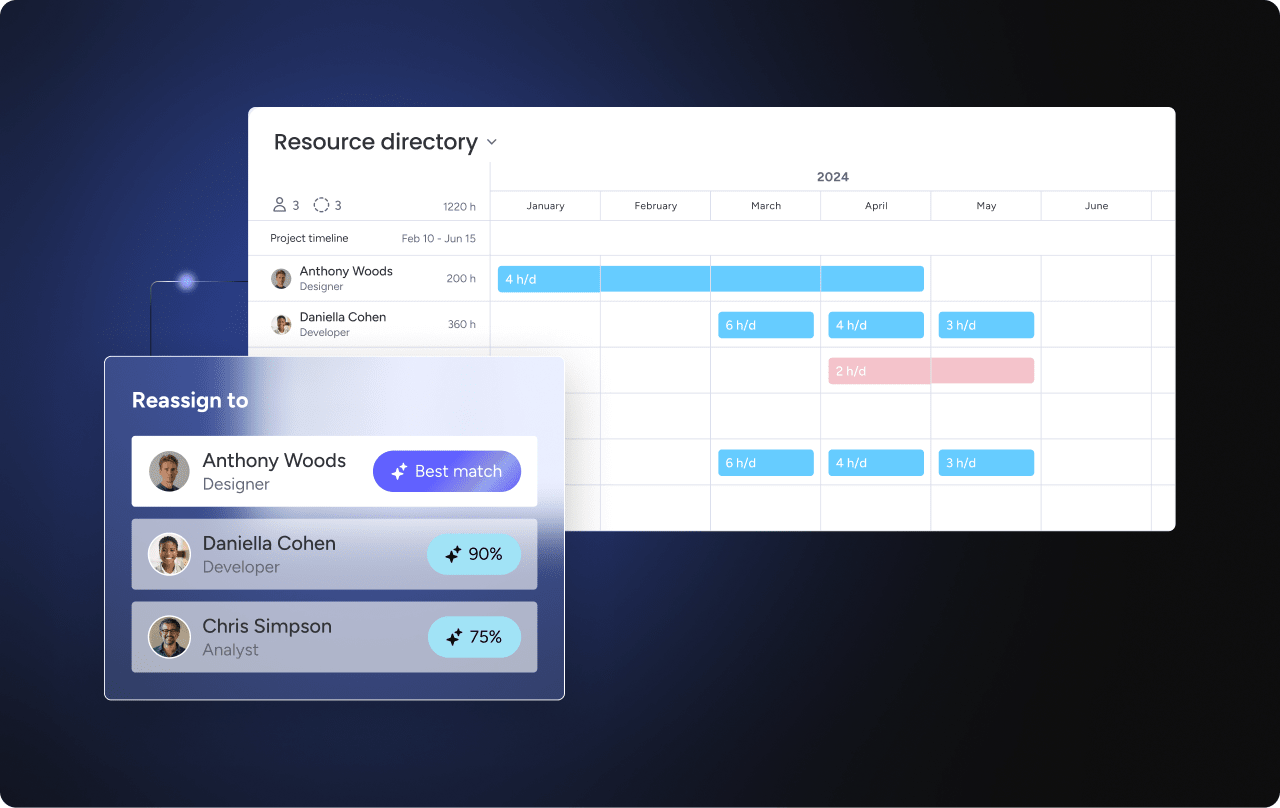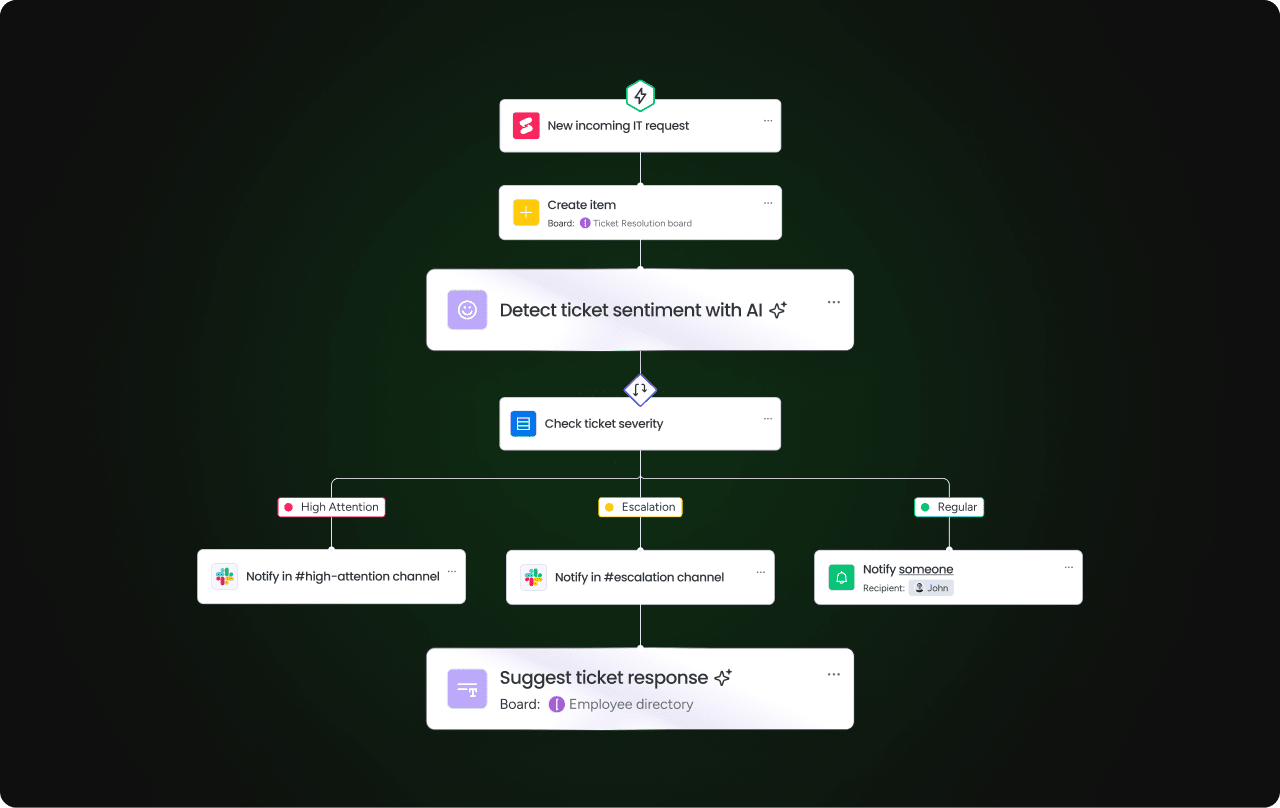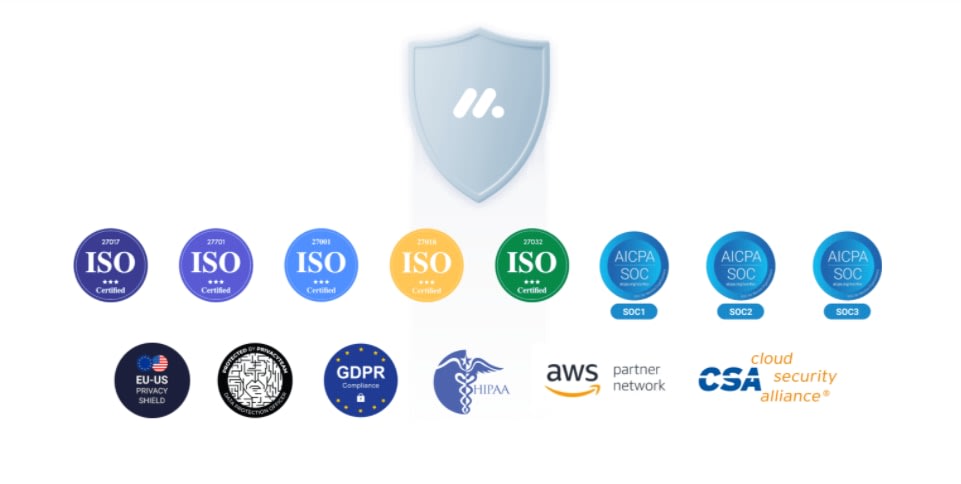Government agencies operate under a unique set of pressures. They must deliver essential public services consistently while navigating strict budget cycles and complex regulatory demands. This balancing act makes effective capacity management for government agencies not just a goal, but a core operational necessity for fulfilling their public mission.
Without a clear view of resource allocation and workload, departments often work in silos, relying on disconnected spreadsheets and manual tracking. This lack of visibility makes it difficult to justify budgets, adapt to policy changes, or ensure compliance. A unified platform like monday work management provides the cross-departmental transparency needed to align resources with strategic priorities and maintain service continuity.
This article walks through five key strategies for building sustainable capacity in a government setting. We will explore how to define roles, centralize collaboration, and leverage automation to meet mandates. The guide also covers how to align projects with long term goals and foster the team buy in needed for success.
Key takeaways
- Government capacity management balances resources against unique public sector constraints including compliance mandates, fixed budgets, and accountability standards.
- Effective models ensure regulatory compliance, justify budgets with data, maintain service continuity , and mitigate risks before they impact public services.
- Build lasting capacity by defining clear roles, centralizing collaboration, standardizing reporting, automating processes, and continuously upskilling staff.
- monday work management eliminates silos with unified platforms that create cross-agency visibility and maintain essential documentation for public sector accountability.
- AI and automation optimize resource allocation, provide real-time forecasting, and handle routine processes while maintaining compliance and freeing staff for higher-valuework.
Understanding capacity management in public sectors
Capacity management for government agencies is the strategic process of balancing available resources — including personnel, budget, and technology — with workload demands to ensure consistent public service delivery while meeting regulatory requirements. Unlike private sector capacity management, government agencies must navigate unique constraints such as compliance mandates, fixed budget cycles, and public accountability standards.
Government capacity management involves coordinating multiple elements to maintain operational effectiveness. These core components work together to create a comprehensive approach that addresses the specific challenges public sector organizations face:
- Resource allocation: distributing personnel, budget, and technology across programs based on statutory requirements and citizen needs
- Demand forecasting: predicting future workload based on policy changes, seasonal variations, and evolving public service requirements
- Performance monitoring: tracking outcomes against established benchmarks and regulatory compliance standards
- Risk mitigation: identifying potential bottlenecks before they impact service delivery or create compliance issues
The foundation of effective governance
Capacity management serves as the backbone of government operations, ensuring agencies can fulfill their public service mission while maintaining fiscal responsibility and regulatory compliance.
Why agencies need a strong capacity model
Government leaders face mounting pressure to deliver consistent public services while operating within strict budget constraints and regulatory frameworks. A robust capacity model provides the foundation for making data-driven decisions that satisfy oversight bodies, optimize taxpayer resources, and maintain service quality during periods of change—as demonstrated by a McKinsey case study in which a federal agency’s analytics showed it needed five times fewer new positions than previously requested.
Key benefits of a government-focused model
Effective capacity models deliver outcomes that matter most to government executives and department heads. These benefits directly address the unique obligations and challenges that public sector organizations encounter:
- Regulatory compliance: ensures adequate resources for mandatory reporting, audits, and statutory deadlines
- Budget justification: provides concrete, data-driven evidence for resource requests to oversight bodies and legislative committees
- Service continuity: maintains consistent public service delivery during staff transitions, leadership changes, and budget cycles
- Risk reduction: identifies capacity gaps before they become public service concerns or compliance violations
Common gaps in traditional approaches
Many agencies still rely on outdated methods like spreadsheets, departmental silos, or annual planning cycles that struggle to capture real-time changes in workload or resource availability. These fragmented systems prevent cross-departmental visibility and make it difficult to respond quickly to shifting priorities or unexpected demands.
monday work management addresses these gaps by providing unified platforms that eliminate information silos and create the transparency necessary for effective government operations. How can agencies maintain strategic alignment when each department operates with its own planning system?
5 strategies to build lasting capacity
Building sustainable capacity requires a systematic approach that addresses both immediate operational needs and long-term strategic objectives. These strategies create a foundation for consistent service delivery while maintaining the flexibility to adapt to changing requirements.
1. Define clear roles and responsibilities
Role clarity prevents resource conflicts and ensures accountability across all levels of government operations. Document who owns which processes, especially during leadership transitions that are common in government environments due to political cycles and career mobility.
Establish clear decision-making authority for resource allocation, project prioritization, and capacity adjustments. This documentation becomes particularly valuable during audits, leadership changes, or when explaining resource decisions to oversight bodies.

2. Establish a centralized collaboration platform
Unified platforms eliminate information silos between departments and create the transparency necessary for effective government operations. Centralized platforms also support the documentation requirements that government agencies face, creating audit trails and maintaining the records necessary for compliance reporting and public accountability.
monday work management provides cross-departmental visibility that enables coordinated planning and real-time resource tracking across multiple agencies or program areas.
3. Standardize data collection and reporting
Consistent metrics enable accurate capacity assessment and support evidence-based decision making. Automated data gathering reduces the manual reporting burden on staff while ensuring that capacity information remains current and reliable.
Standardized reporting also facilitates communication with oversight bodies, legislative committees, and other stakeholders who require regular updates on program performance and resource utilization.
4. Leverage automated processes
Automation frees human resources for higher-value work while ensuring that compliance requirements are consistently met. Automated workflows also reduce the risk of human error in critical processes, supporting the accuracy and reliability that government operations require.
monday work management’s AI capabilities can categorize workload, extract information from documents, and suggest resource allocation based on historical patterns and current demands.

5. Continuously train and upskill staff
Capacity building includes developing internal capabilities, not just managing existing resources. Regular training ensures that staff can adapt to new technologies, changing regulations, and evolving service delivery methods.
Cross-training creates flexibility in resource allocation, allowing agencies to respond to unexpected demands or staff absences without compromising service quality.
Aligning short-term projects with long-term goals
Government agencies must balance immediate demands with strategic objectives while navigating political cycles and changing priorities. This challenge requires frameworks that maintain strategic focus while remaining responsive to urgent needs and shifting mandates.
Effective alignment starts with clear connections between daily operations and broader policy objectives. When team members understand how their work contributes to agency missions and public service goals, they make decisions that support both immediate needs and long-term success — a critical connection, as employees who understand how success is measured are 2x more likely to feel motivated.
How can agencies maintain strategic direction when priorities shift with each budget cycle? The key lies in establishing core capacity principles that remain stable while allowing tactical flexibility in resource allocation and project prioritization.
Evidence-based approaches and policy alignment
Modern government operations increasingly rely on data-driven decision making to support policy development and resource allocation, with research indicating that the knowledge gained from evaluating alternative policies can deliver benefits that exceed 40% of the total budget devoted to those policies. Capacity management provides the foundation for evidence-based approaches by creating reliable data about resource utilization, service delivery outcomes, and operational effectiveness.
Linking data to decision-making
Capacity data informs policy decisions by revealing the true cost and resource requirements of different programs and services. This information supports more accurate budget requests, realistic timeline development, and informed discussions about program expansion or modification.
Data-driven capacity management also supports performance measurement and continuous improvement efforts, providing the metrics necessary to evaluate program effectiveness and identify opportunities for optimization.
Implementing GAO and OMB guidelines
Federal guidelines emphasize the importance of evidence-based policymaking and strategic resource allocation. Capacity management systems support these requirements by providing the data collection, analysis, and reporting capabilities necessary for compliance.
Agencies can use capacity data to demonstrate program effectiveness, justify resource requests, and support strategic planning efforts that align with federal guidance and best practices.
Overcoming budget and compliance challenges
Budget constraints and regulatory requirements create unique challenges for government capacity management, but these constraints also create opportunities for innovation and optimization. Effective capacity management helps agencies accomplish more with existing resources rather than requiring additional funding.
Meeting mandates without sacrificing quality
Proper capacity management enables agencies to identify the most efficient ways to meet regulatory requirements and service delivery standards. By understanding true resource needs and optimizing allocation, agencies can maintain quality while operating within budget constraints.
Strategic resource allocation also helps agencies prepare for budget reductions or changing priorities by identifying which activities are most critical and which can be modified or eliminated if necessary.
Building stakeholder trust through transparency
Visible capacity management builds confidence with oversight bodies, legislative committees, and the public by demonstrating responsible resource stewardship and effective program management. Transparency in resource allocation and performance measurement supports accountability and public trust.
Regular reporting on capacity utilization and service delivery outcomes provides stakeholders with the information they need to evaluate agency performance and support future resource requests.
Implementing platforms and technology for capacity planning
Technology selection for government agencies requires careful consideration of security, compliance, and integration requirements. The right platform must support both operational needs and regulatory obligations while providing the scalability necessary for multi-department operations.
| Consideration | Government Requirement | Platform Capability |
|---|---|---|
| Security | FedRAMP compliance, data protection | Enterprise-grade security, audit trails |
| Integration | Legacy system compatibility | API connectivity, flexible data exchange |
| Scalability | Multi-department, multi-agency use | Unlimited users, customizable workflows |
| Compliance | Audit requirements, record retention | Automated documentation, reporting capabilities |
Selecting a secure, scalable platform
Government-specific requirements include security clearances, compliance standards, and the ability to handle sensitive information according to federal guidelines. Platforms must also support the collaboration needs of large, distributed organizations while maintaining appropriate access controls.
monday work management meets these requirements with enterprise-grade security, comprehensive audit capabilities, and the flexibility to support diverse government workflows while maintaining compliance with federal standards.

Ensuring interoperability with existing systems
Agencies must work with existing technology investments while gradually modernizing their capacity management capabilities. Successful platforms provide integration options that allow gradual transition without disrupting ongoing operations.
API connectivity and flexible data exchange capabilities enable agencies to connect capacity management systems with existing financial, HR, and program management platforms, creating comprehensive visibility without requiring complete system replacement.
How to foster team buy-in and collaboration
Government culture often includes established processes, hierarchical structures, and resistance to change that can challenge capacity management implementation. Successful adoption requires change management approaches that respect existing culture while demonstrating clear value.
Strategies for change management
Focus on communication that emphasizes how capacity management supports mission accomplishment and public service rather than simply improving efficiency. Government employees are motivated by service to the public, so frame changes in terms of enhanced service delivery and mission effectiveness.
Provide training and support that acknowledges the unique challenges of government work, especially since there is often a perception gap to bridge — research shows that while 45% of senior leaders believe change is managed ‘very well,’ only 23% of individual contributors agree.
Encouraging cross-agency communication
Break down traditional silos by creating shared visibility into resource needs, project timelines, and service delivery outcomes. Cross-agency collaboration becomes particularly important during emergencies, major initiatives, or budget constraints when resources must be shared or reallocated quickly to maintain service delivery.
monday work management facilitates this communication by providing platforms where different agencies can coordinate activities and share resources effectively.
Emerging opportunities with AI and automation
Artificial intelligence and automation offer significant opportunities for government capacity management, particularly in areas where manual processes drain staff time, as cutting-edge AI systems are expanding their task capacity every seven months, according to recent testing by the research group METR.
Government agencies can leverage these emerging technologies to enhance their capacity management capabilities while maintaining the security and compliance standards required for public sector operations:
- AI-driven resource allocation: optimize staff assignments based on skills, availability, project requirements, and historical performance data
- Real-time forecasting and risk detection: anticipate capacity needs based on historical patterns, seasonal variations, and policy changes
- Digital workforce support: handle routine government processes such as data entry, report generation, and compliance monitoring
- Security and compliance with automated workflows: improve compliance while maintaining security standards through consistent process execution
monday work management’s Digital Workforce capabilities continuously learn and improve, adapting to changing requirements while maintaining the accuracy and consistency that government operations require.

Putting it all together for government success
Effective capacity management transforms government operations by creating the visibility, coordination, and strategic alignment necessary for consistent public service delivery. The strategies outlined here provide a roadmap for building sustainable capacity that supports both immediate operational needs and long-term strategic objectives.
Success requires commitment to systematic implementation, ongoing training, and continuous improvement based on performance data and stakeholder feedback. Agencies that invest in comprehensive capacity management create the foundation for enhanced service delivery, improved resource stewardship, and stronger public trust.
The combination of clear processes, appropriate technology, and skilled staff creates capacity management systems that adapt to changing requirements while maintaining the stability and reliability that government operations require. This strategic approach enables agencies to fulfill their public service mission while demonstrating responsible stewardship of taxpayer resources and maintaining the highest standards of accountability.
FAQs
What is capacity management in government agencies?
Capacity management in government agencies is the strategic process of balancing available resources with workload demands to ensure consistent public service delivery while meeting regulatory requirements. It involves coordinating personnel, budget, and technology across departments to optimize resource utilization and maintain compliance with federal guidelines.
How do government agencies measure capacity management success?
Government agencies measure capacity management success through service delivery metrics, budget utilization rates, compliance audit results, and stakeholder satisfaction scores. Key indicators include meeting statutory deadlines, maintaining service quality standards, and demonstrating efficient resource allocation to oversight bodies.
What are the main challenges in government capacity planning?
The main challenges in government capacity planning include budget constraints, complex regulatory compliance requirements, and coordination across multiple departments with different priorities. Agencies also face difficulties with legacy system integration, political pressure for immediate results, and adapting to changing policy mandates.
How can government agencies respond quickly to unforeseen demands?
Government agencies can respond quickly to unforeseen demands by maintaining flexible resource pools, cross-trained staff who can be reassigned as needed, and real-time capacity monitoring systems. Automated workflows and centralized platforms enable rapid identification of available resources and streamlined reallocation processes during emergencies or priority shifts.
What role does technology play in government capacity management?
Technology plays a crucial role in government capacity management by providing real-time visibility into resource utilization, automating routine processes, and enabling cross-departmental collaboration. Modern platforms support compliance requirements while offering the scalability and security necessary for government operations.
How can AI improve government capacity planning processes?
AI improves government capacity planning by analyzing historical data to predict future resource needs, identifying potential bottlenecks before they impact service delivery, and optimizing staff assignments based on skills and availability. Automated systems handle routine capacity assessments while maintaining the accuracy and audit trails required for government accountability.

